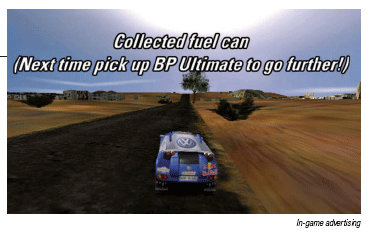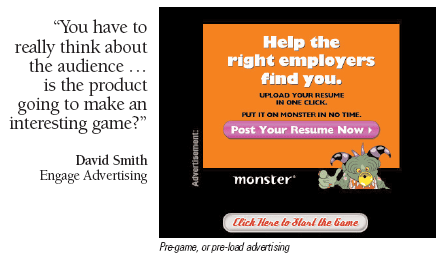The Power Of Advergaming: Brand Acceleration

All work and no play makes Jack a dull boy, goes the adage. That may be one reason that online gaming is so wildly popular these days. And many savvy marketers are finding that by providing a positive entertainment experience with consumers through advergaming, big dividends can result.
Advergaming (often called in-game advertising) is the practice of using games, particularly Web-based games, to promote an organization's brand or product. There are essentially two levels of advergaming; in-game and pre-game.
In-game advertising is closely associated with product placement in that either a logo is included in a generic sponsorship fashion, or an entire game is developed around a company's brand and corporate objectives.
BP Amoco released "BP Ultimate Rally Challenge," with one of the objectives being to pick up gas cans along the race course. Picking up BP Ultimate gas would invoke the message "Cleaner Engine, More Power, More Mileage" and when a can of regular gas was collected, "Next time pick up BP Ultimate to go further!" was displayed. The BP gas allows the user to progress further in the game. In addition, road signs for BPAmoco were prominently displayed throughout the course. By taking full advantage of this interactivity, advertisers can be confident that consumers are fully engaged with their product or brand the entire time the game is being played.

The second style of advergaming is commonly known as pre-game (or pre-load) advertising. While the game is loading, advertisers' messages will pop up or scroll across the gaming screen. As most end-users are willing to exchange a few moments of their time with a sponsor in exchange for the entertainment, pre-game is a very popular means to reach a captive audience - currently used by companies and organizations such as AT&T and the US Army.
While online subscriptions remain a fraction of the estimated $29 billion in overall video game sales in 2005, San Diego, Calif.-based DFC Intelligence expects the segment will reach $6.8 billion in sales by 2011. With growth like this, advergaming is poised to go mainstream and may soon be top shelf in the advertiser's promotional arsenal.
The Demographics:
Exactly who plays these online games may surprise you. According to one provider of online games, Shockwave.com, the audience is 48% male and 52% female. The average age is relatively evenly dispersed with 13% of users aged 18-24, 18% at 25-34, 27% at 35-44, 25% at 45-55 and 17% over 55. In addition, most have incomes over $50,000, have a college degree (or some college education) and a large majority (82%) have a broadband connection - with 95% going online at least three times per week.
(Article continued below)

Making a Great Advergame
Most of the games users find on the Web at online gaming portals such as MiniClip.com, are created with Flash (Macromedia). Creating a great game visually, however, is only part of the overall advergaming process. The ability of the game to connect with users is crucial. According to David Smith of Engage Advertising, "You have to really think about the audienceis the product going to make an interesting game?" And it is the "interesting" advergames that users want to play.
Advergames that create a positive connection between the brand and the consumer, while remaining challenging, secure the greatest brand awareness. Andrew Keplinger of Left Brain Games, Inc. says, "Games must be simple to learn, but take a long time to master." The result is a captive audience with a longer exposure to marketing messages.
Benefits and Barriers
The appeal of advergaming is that it allows marketing departments to gather consumer data and build their brand - all while engaging their consumers with entertainment.
While some view the cost of producing an advergame ($10-$100,000) as excessive, the benefits can, in some cases (brand awareness, and viral marketing in the case of multiplayer games), outweigh production costs for many advertisers.
Since advergames are often played repeatedly by the same individual, they are able to reinforce a brand, present a new brand, or a new product, sometimes better than traditional methods. Only with a strategic understanding of a consumer's needs and desires, coupled with breakthrough creative ideas, can brand acceleration via advergaming exist.
The kinds of companies that are willing to take a risk trying their hand at advergaming are some pretty conservative, traditional companies such as BP Amoco, American Express and Wrigley. -

Subscribe to Our Newsletter!
Latest in Marketing








